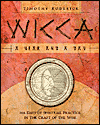
With Wiccan “teachers” popping up every time we log on, New Age “shamans” offering workshops in every bookstore in town, and Wicca 101 books being written by people who should be reading them, it’s no wonder that some new witches have little understanding of what magic is or what a witch really does. A young witch, no matter what his or her age, needs to be grounded in the fundamental knowledge of the Craft of the Wise. The new witch needs a trustworthy guide along the yellow brick road to wisdom; and lessons in how to discern the many detours along the way.
Timothy Roderick has given us a year and a day course in which there is genuine work to do on every single day. It’s a cornucopia of a book, with basic information (lessons in the eight sabbats, tables of correspondences, divination, the elements, herbs, spellwork, ritual tools, etc.) plus introductions to the three aspects of the Goddess (the familiar Maiden, Mother, and Crone) and the God (the less familiar Inseminator, Provider, and Sage). Roderick devotes several days to each sabbat, telling us its meaning and history, giving suggestions for rituals, and explaining how to apply the lessons of the sabbat to our mundane lives. At Yule, for example, we learn to banish winter shadows (which may be our own psychological shadows). Then we practice “knowing the rules” by making a list of ten socially enforced rules that come from our culture, a second list of rules we’re supposed to follow as members of our gender and a third list of rules we’re supposed to follow as members of our family (Day 70).
In addition to active days when the reader makes oils, incenses, and tools and learns the steps to casting the circle, there are also quieter days when we learn to meditate and contemplate. A contemplative day is one during which we sit for a few minutes pondering one of the Big Questions of Life and then go about our daily business in the world. “Be prepared,” Roderick writes, “to receive an intuitive answer at any given moment. Give this process time and eventually a shift in your perception will take place through which you will realize your own answer” (Day 33, p. 35).
An issue not much discussed in other books is balance. When we’re new witches, we get excited, we get caught up in rituals and witchen garb, we start collecting every possible tool and altar tchotchke. We go over the edge. Everyone does it. Days 98 through 101 provide an anodyne to unbalance. Roderick talks about balancing our actions, our thinking, our emotions, and our spirituality. Being a witch, he writes, is not being weird (or wyrd) all the time:
One does not need to search for [spirit] … incessantly…. It is important to see that going to the bathroom is just as important to spiritual development as chanting … or working a spell. An authentic and genuinely magical life is one infused with the essence of one’s spiritual practice, but it does not focus on the external artifacts of one’s spirituality. … [C]are should be taken that [tarot cards, candles, incense, etc.] do not become crutches or objects of obsessive fascination (Day 101, p. 97).
The one major error in the book is not Roderick’s fault. The invoking and banishing pentacles (Days 238, 239, 240, 241) were inserted incorrectly by an editor who obviously didn’t know what they signified. Roderick, a trained British Traditional Gardnerian, knows what’s what. For correct pentacles, go to Roderick’s earlier book, Dark Moon Mysteries (Llewellyn, 1996) and see pages 186 to 188. Draw corrections in your copy of Wicca: A Year and a Day.
~review by Barbara Ardinger, Ph.D.
Author: Timothy Roderick
Llewellyn, 2005
